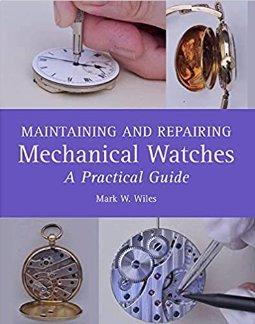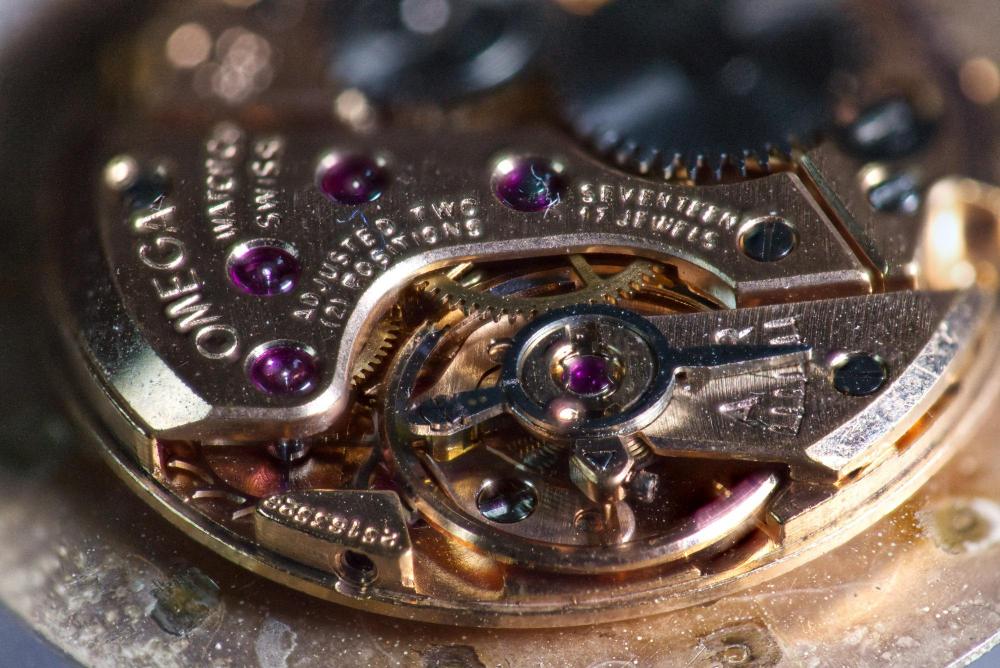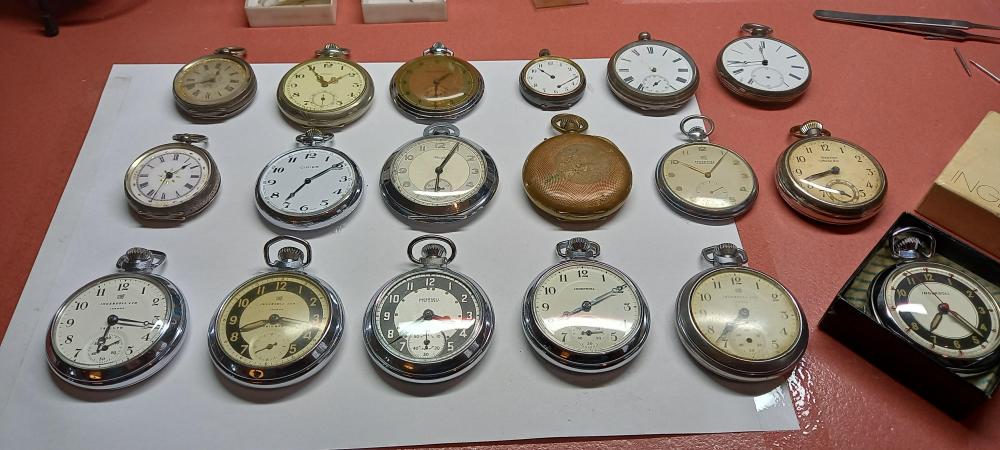Leaderboard
Popular Content
Showing content with the highest reputation on 06/08/22 in all areas
-
This advice in the light of my personal experience made me thinking about an apron „Even if you think you are not the apron type, I would strongly advocate the use of one, unless you wish to spend most of your time under the bench with a torch and magnetic strip…Bulldog clips are used to secure the bottom part of your apron to the edge of the bench or table you will be working at, to create the safety net mentioned earlier. “ (Excerpt from: Maintaining and Repairing Mechanical Watches by Mark W Wiles)2 points
-
Any part that had shellac I always cleaned it in Ronsonal lighter fluid. I have said that many times on this forum. It is safe you could leave the parts in it for days and it won't come to any harm. Get yourself a small screw on lid jar as it evaporates quick. It is not a rerecorded watch cleaning agent but it works and does a fine job.2 points
-
I've tried this before but this is recommended for clocks only. It doesn't work as well as commercial cleaners. The brass comes out shinier but a little patchy. Dried up grease doesn't come off very well. And some steel parts will start to rust the moment it comes out of the solution. I suspect commercial cleaners contain a rust inhibitor which is not listed in the MSDS. L&R #111 is a very good cleaner. It removes stubborn grease, shines up brass and doesn't smell half bad if used in a sealed jar in the ultrasonic. The only drawback is the price. It costs $180 SGD in Singapore, which is about £100. And you need the #3 rinse which is the same price. I try to stretch my dollar by doing a manual pre-clean when disassembling and a pre-soak in benzine before putting it in the #111. And when the solution looks a little cloudy, I put the jar in the freezer to freeze-distill some of the dissolved oils, then filter the solution to remove any particulate matter. But #111 is way too expensive to use for clocks.2 points
-
I continue my search for interesting books and recently received this book. Unlike some of the older reprints (Practical Watch Repairing by Donald de Carle originally published in 1946 or The Watch Repairer's Manual by Henry B. Fried originally published in 1949 but updated in 1961) this one was copyrighted in 2016, so it is up-to-date as far as tools, oils, time graphers, suppliers, etc... The author approaches his presentation targeting the hobbyist rather than the aspiring watchmaker. In my opinion there's a difference in the approach. Like Mark's online courseware, this book references a simple Unitas/ETA 6497 movement (or the Seagull ST25 which is relatively large, cheap and available). I highly recommend this book for the beginner who has yet to pay for any other instruction but who is looking for more than watching 1 hour YouTube videos hoping to pick things up by watching.2 points
-
The primary parts missing are the reamers. Looks like a few pushers are missing too, but that's not a big deal. You can get a set of reamers from Horia that will work with this tool for about 200 bucks, so to get it fully functional you're at 400 or so, which honestly is OK for a tool like this, with all the other parts that are there. One really nice thing with these as opposed to Seitz is the spindle for holding the reamers takes little precision collets, made by Schaublin. Those are 80-115 bucks each in the normal sizes (more for the more oddball ones). This set looks to have them all, which would be from 0.5mm to 3mm, with an additional (in the spindle in the pic) at 2.2mm, which for whatever reason is the body size of the reamers. These are often missing some to all of them. With the additional sizes you can easily hold drills and taps, a very useful thing. It won't work with Seitz reamers since they are held in a special spindle by a taper fit. But it will work with Seitz pushers, which are reasonably priced from watch material suppliers.2 points
-
I purchased this movement some weeks ago and it wants to run. I haven't yet done anything with it because I keep fouling things up with washing the balance and destroying the hairsprings. I'm also still shooting screws all over the place but the new tweezers I got seem to be better (or maybe it's just me)? Anyway, I also got a macro filter to get me somewhat closer than my 100M28 macro lens. This is a focus merge stack of 12 exposures. I see some distortion around the text on the bridge and wonder if instead of 12 shots if I had made smaller focus adjustments and merged 48 instead. Will need to experiment. Also (as noted elsewhere) I pulled the trigger on a trinocular AmScope 7x - 45x boom stand microscope. The scope ought to allow me to drop one of my cameras into the third tube.1 point
-
It looks easier to operate than the Ollie Baker. The click to change direction is far better than the Ollie which can be a bit fiddly. Also only two chucks required for the different size arbours. The Ollie requires changing arbour holders to match the different size arbours. It certainly looks solidly built.1 point
-
You might never find the part number or the actual part but if you look on Cousins UK they have a large selection of generic crowns for pretty much any size or style. BTW the 6 digits number is the date / serial number, not the case reference.1 point
-
Time for a quick drift off topic once more.. A few months back, I was doing a little tidying up and realised, we have quite a large collection of cassette tapes, but the only tape player we currently have that is functional, would hardly do justice to any of them. So with that in mind I had a quick hunt on every-bodies favourite flea market, ebay. I should know better by now. Initially I wondered if I might even be able to pick up a 404 club cassette deck. Perhaps I should explain my thinking a little further. Back in the day, I used to do board level repairs of electronic equipment. Computers, CRT monitors, tape drives, hard disks, amongst other things, so my idea was to see if I could find a quality deck, in need of a little TLC and do it up. So.. naturally.. I bought two. A Denon DRW-650 double cassette tape deck, and as a bit of a long shot, a Memorex SCT-88. There were many more, some of which I no doubt drooled over in the HiFi stores back in the day, but those two looked like they were good candidates for restoration. The Memorex is actually a re-badged Aiwa RD470 or possibly the similar spec R40. Either way it has the quirky Aiwa quick reverse mechanism which made it a bit of a "sort of 3 head" system. These units were also sold by Tandy with their in house Optimus branding. The Denon was a fiver and the Aiwa, a little more at eight pounds, with of course a similar amount for shipping. Both are listed as untested spares or repair, where "untested" is ebay speak for "I did switch it on, and it didn't work, so I'm going to list it as untested spares or repair". I suspect they will both need cleaning, lubrication, belts, a head clean and degauss and alignments and a motor speed check. I probably already have suitable belts in my stash, so fingers crossed, I'll soon be cranking out those old dolby enhanced tapes like its 1989. It seem that cassette decks have fallen out of fashion for the time being. Although some of the really high end 3 head systems are still selling for thousands, there are actually quite a large number of good pieces of quality equipment at relatively low prices. So.. for good measure, I picked up a Dual CS503-1 HiFi Turntable. Also listed as spares or repair, but looking pretty clean and complete with original cartridge. That cost a little more though at just over twenty pounds.1 point
-
1 point
-
Depends on who's school of thought you follow. I've been taught to fit the balance back to the mainplate and then clean as one. I do take the balance off the mainplate afterwards and dip it into Once Dip like I do for the pallet fork. Yeah, IPA as in alcohol and I assume that it's pretty much the same all over the world. Because some people have no issue with pallet forks in IPA, while others do, all I can think is that the type of Shellac would be different (makes sense to me at least because it's an organic compound), hence my comment above.1 point
-
When hardening it's good to protect the part from direct flame. This is often done by wrapping in iron wire and coating with pure soap, or sometimes borax, or sometimes a commercial anti-scale powder (a great one is available from gunsmith supplier Brownell's). I have a slightly different technique, using 20mm iron tubes on a handle, in which the part is placed the tube then filled with fine wood charcoal powder. Whatever the technique, even heating and avoidance of oxygen is the goal. The part, when at proper temperature, is then quenched. For blueing his method is very good. I also put the part (which when done with the above anti-scale measures should be a clean grey, otherwise the black scale must be cleaned off to see the color change [and it should be clean of oil]) on brass fillings in a pan, over an alcohol flame. From the quench the steel is at its maximum hardness, and is very brittle. Heating to a lower temperature is called tempering, and blue is pretty much the standard color for watch components. The steel changes color at different temperatures, from a light straw to brown, then purple, dark blue, blue, light blue, then almost grey again. For a cutting tool you would temper to straw. Using the pan with filings helps ensure an even heating, and prolongs the process so that the temperature reaches into the part as well. For parts larger than watch-size you would need to do it in an oven for a specific amount of time for a given cross section. The thread pitches on the Habegger rolling dies are the modern standard pitches according to NIHS. If you look at the Asco Schurch catalog, on the taps pages, they list the pitch for each diameter- as well as the tap drill size for both steel and brass which is great. From memory, the Martin B (Bourgeaux) plates are quite close to the modern norm in pitch for a given diameter. Also from memory, the L or Latard plates are slightly finer pitch. As a bit of trivia- and this is from my observation, not a book, the Martin B holes correspond to the seemingly oddly-backward "tap size" for watch stems.1 point
-
This was pure joy to watch. Several questions though. 1) Is indirect heating better than direct? Is that holder steel? What is it called? 2) What is the purpose of bluing? I thought it was to have a blue result, but evidently not. 3) What is the stuff he is using to blue? 4) I looked at the forming tool at the site given by @nickelsilver. Seems the options are diameter but not thread pitch. Thread pitch for watch screws still has my brain wrapped in a knot. The screws I have made were cut using a screwplate and I have several different versions of the Martin Fills (L and B) that I use when I blindly try to fit the proper size. So, what are the thread pitches for these.1 point
-
Yes, and if you leave watch parts in normal commercial watch cleaner like L&R 111a for 6 hours you will probably see damage to plating and worse! I remember a classmate forgot a watch in 111a over the weekend... it was a goner.1 point
-
IPA is typically used as last rinse and water removal. The process time is typically 3 minutes. This time will do little to no harm to the shellac. However, according Paul's experiment, all shellac will be gone after 120 rinses! Frank1 point
-
That's very similar to a mix I found in an old book and also one the local drugstore used to mix up for clockmakers around here, they called it soupe Vaudoise (canton Vaud is a big watchmaking area). I've used a recipe from the Finnish watchmaking school for years, no problem, no rust, if anything it's a little too gentle- but I'd rather pre-clean and have a gentle cleaner than have one that etches the plates. It's probably been posted above somewhere, but here again 1L 99% isopropyl alcohol 3L distilled water 50g oxalic acid 60g oleic acid around 80 grams of 24% ammonia In a stainless pot, heat the alcohol and 1L water, add the oxalic acid (powder) and dissolve, add the rest of the water and oleic acid, then add ammonia slowly. It will go cloudy, then turn clear. The ammonia is reacting with the oleic acid making a soap, when it goes clear all the oleic has reacted. This keeps the solution fairly safe for brass, as the ammonia now being a soap doesn't eat the metal like some other cleaners with higher ammonia concentrations. Rinse in hot water, with a final bath in alcohol before drying with hot air. I have never had a part rust with this, but the final alcohol rinse is important. In that one there's no added soap, since the oleic and ammonia have made a soap. Not sure why Mike adds so much- but again, I've seen similar other solutions. I've also posted somewhere in the past a recipe Gruen suggests when the watchmaker doesn't have access to proper solutions: Gruen recipe: 1 ounce oleic acid 2 ounces acetone 4 ounces 22% ammonia 25 ounces distilled water Not that different than the Finnish one. The oxalic acid in the Finnish one is a common chemical used to remove rust stains; in high concentration it will remove heavy rust as well. In this dilute concentration I wonder if it acts more as a preventative? Like I said I haven't had rust issues with it. Some will say never use a water based cleaner as- wait for it- it will rust parts. I used Greiner GS watch concentrate as my watch cleaner for many years; this is water based, mixed 1:19 with water, and rinsed in alcohol (in a purpose made machine from Greiner in my case). Once again, no rust issues, and no issues with shellac dissolving unless I forgot the parts in the (hot) alcohol for quite a while.1 point
-
Cheeky It's only happened to me once and I keep expecting another incident. Mine was also my father. It wasn't a dream - I was awake. Hang in there. The universe is a big place and this will sort itself out for you. Theres so much more to this world than a lot of people realise or more accurately want to realise.1 point
-
If I’m completely honest, I’ve tried the route of tetrachloroethylene as a replacement for One Dip or B Dip. While tetrachloroethylene on its own does an ok job, it’s still not as good as B Dip at the end. Yes, I know tetrachloroethylene is a key ingredient in B Dip (they both even have the same odour), but Bergeon obviously has something else they add to spice up the mix. A 50ml bottle of B Dip goes a long way so I would get a bottle if I was you. I do agree on the merits of a home made cleaning solution in your case (where importing commercial cleaners are a problem) especially in large quantities. I also use a locally available brew that seems very close to what your link above describes.1 point
-
I can only agree. I have it as well and I think it’s a good resource for a beginner for little money1 point
-
I just pulled the trigger on eBay on a trinocular AmScope 7x - 45x boom stand microscope. I ought to be able to drop one of my cameras easily into the third tube. I have the adapters to use my APS-C Sony on our telescopes but I might get the two adapters needed to use one of my MFT Panasonics (since they're smaller). Stay tuned...1 point
-
Hi You can purchase single stumps and stakes on ebay at approx £7 a piece so by the time you have replaced the missing parts ypu would have bought a new chinese version from Alo Express.1 point
-
Because the click is designed to hold the spring and the winding mechanism is not, although it does. Probably it's standing a pressure (against the winding direction) that should be supported by the click instead, and that might affect other characteristics, for example the ability to self-wind or the wear of the pawl lever tips and the 2nd reduction wheel teeth. That could explain a poor power reserve, but here I'm just guessing.1 point
-
Maybe ? Look at pictures of other Juvenia watches being sold on line, that have the same movement. You may be able to see the markings on the inside of the case back if the seller puts up comprehensive photos. Then, armed with the name of the case maker, you MIGHT be able to search for other cases or case backs that would work. I think you are going to find this to be one of those instances where you are looking for weeks or months, and having to buy some "lots" of older watches / cases and cross your fingers that you find one. Randy1 point
-
1 point
-
a example of this would be the bestfit books. I snipped out a couple of relevant pages. As you can see with just dimensions you can figure out what staff and/or stem you have. then once you get a part number somewhere else in the book you'll tell you which watches use that part number. Another interesting feature of this is mystery watches? another thing you can use these sections for would be if you have a watch that you don't know what it is. You can then measure the stem and find one close and see if any of the watches match what you have.1 point
-
No, these books also contain tables that are sorted by length, not by maker. Frank1 point
-
Ok so I'm a bit gutted I've just worked out my latest acquisition from ebay. 83 quid for 17 pocket watches. Which calculates to £4.88 each and not the required 404. Gutted I've not made the mark but very pleased with my purchase. Which includes 6 Ingersol not inc. the boxed one this was a seperate purchase at yesterdays carboot hunt. A kienzle, a cimier, a westclox, an excelsa, a french chronometre, 5 unnamed 4 of which are silver inc. 2 ladies, and a brass full hunter. Some of these ive not been able to get in the back as yet. This comes from the man that wasnt particularly interested in pocket watches that now has a total of 20. Hence Neverenoughwatches, which i may now have to change to neverenoughwatchesandpocketwatches.1 point
-
Not really. Having one of the reference books (or its copy from Cousins), e.g Ronda, you can start with total length and get a much smaller selection. Then select by next important size, the rivet shoulder, and get a smaller selection again. And so on. Time consuming anyway if you have lots of staffs to sort. Frank1 point
-
1 point
-
Definitley not worth the bother, if they are broke they are useless unless you have the wherewithall to effect repairs even thenI dont think they would be trust worthy .1 point
-
I Think we are looking at a NO answer. As most staffs are rivited on the the balance wheel hub means to remove it without damaging the hub the rivit has to be cut off using a lathe or the likes of a Platax tool (Bergeon), or the K&D staff removal tools. doing this renders the staff useless. Any attempt to recut the seat results in the removal of metal and if you could re fit it will result in weight issues and poise issues. So therfore not reccomended.1 point
-
That is never necessary. The formula for MS (or any other regular spiral) length is accurate https://www.engineeringtoolbox.com/spiral-length-d_2191.html Applied to watchmaking http://theindex.nawcc.org/CalcMainspringLength.php So you can keep the original part in case no replacement is available after all, future reference, or just out of respect to for non-destructive science.1 point
-
I would like to share a simple modification of a cheap Chinese demagnetizer. I found the modification in this video: https://www.youtube.com/watch?v=AhTYBPdJG7A. I applied this modification in a newly bought demagnetizer (from Aliexpress) and it works quite well.1 point














